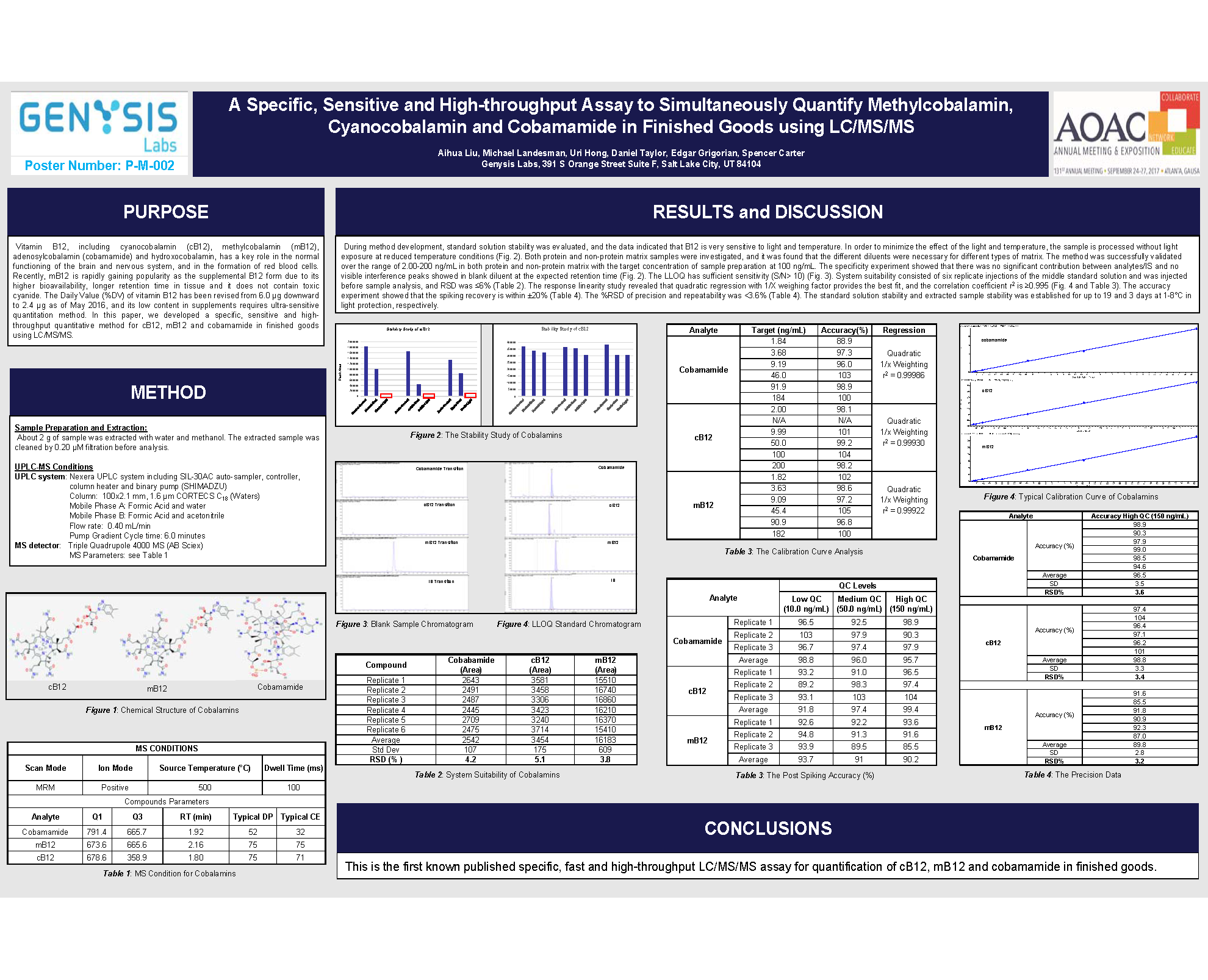Simultaneously Quantifying Methylcobalamin, Cyanocobalamin and Cobamamide in Finished Goods using LC/MS/MS

A Specific, Sensitive and High-throughput Assay to Simultaneously Quantify Methylcobalamin,
Cyanocobalamin and Cobamamide in Finished Goods using LC/MS/MS
Purpose
Vitamin B12, including cyanocobalamin (cB12), methylcobalamin (mB12), adenosylcobalamin (cobamamide), and hydroxocobalamin, has a key role in the normal functioning of the brain and nervous system, and in the formation of red blood cells. Recently, mB12 is rapidly gaining popularity as the supplemental B12 form due to its higher bioavailability, longer retention time in tissue, and the absence of toxic cyanide. The Daily Value (%DV) of vitamin B12 has been revised from 6.0 μg downward to 2.4 μg as of May 2016, and its low content in supplements requires an ultra-sensitive quantitation method. In this paper, we developed a specific, sensitive, and high-throughput quantitative method for cB12, mB12, and cobamamide in finished goods using LC/MS/MS.
Method
Sample Preparation and Extraction:
About 2 g of sample was extracted with water and methanol. The extracted sample was filtered through a 0.20 μm filter before analysis.
UPLC-MS Conditions
UPLC system:
- Nexera UPLC system including SIL-30AC auto-sampler, controller, column heater and binary pump (SHIMADZU)
- Column: 100×2.1 mm, 1.6 μm CORTECS C18 (Waters)
- Mobile Phase A: Formic Acid and water
- Mobile Phase B: Formic Acid and Acetonitrile
- Flow rate: 0.40 mL/min
- Pump Gradient Cycle time: 6.0 minutes
MS detector: Triple Quadrupole 4000 MS (AB Sciex)
Results and Discussion
During method development, the stability of the standard solution was evaluated, and the data indicated that B12 is highly sensitive to light and temperature. In order to minimize the effect of the light and temperature, the sample is processed without light exposure at reduced temperature conditions. Both protein and non-protein matrix samples were investigated, and it was found that different diluents were necessary for different types of matrix. The method was successfully validated over the range of 2.00-200 ng/mL in both protein and non-protein matrices with the target concentration of sample preparation at 100 ng/mL. The specificity experiment showed that there was no significant contribution from analytes/IS, and no visible interference peaks were shown in the blank diluent at the expected retention time. The LLOQ has sufficient sensitivity (S/N> 10). System suitability consisted of six replicate injections of the middle standard solution, which was injected before sample analysis, and the relative standard deviation (RSD) was ≤6%. The response linearity study revealed that quadratic regression with a 1/X weighing factor provides the best fit, and the correlation coefficient r2 is ≥0.995. The accuracy experiment showed that the spiking recovery is within ±20%. The %RSD of precision and repeatability was <3.6%. The stability of the standard solution and the extracted sample was established for up to 19 and 3 days at 1-8°C, respectively, under light protection.
Conclusions
This is the first known published specific, fast, and high-throughput LC/MS/MS assay for quantification of cB12, mB12, and cobamamide in finished goods.